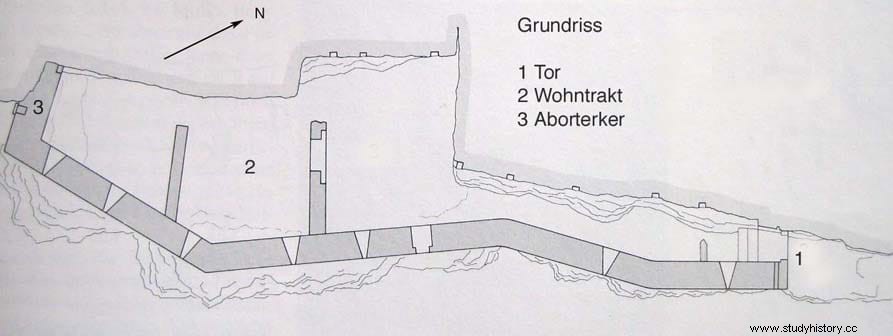The Swiss commune of Waltensburg, located in the Graubünden canton in the center-east of the country and which today has just 300 inhabitants, was so important during the Middle Ages that it was home to four castles:Jörgenberg, Grünenfels, Vogelberg and Kropfenstein.
Only ruins remain of them. However, the one at Kropfenstein is especially interesting because it was built on the wall of a high cliff at an altitude of 1,130 metres. Although it is true that in many places around the world there are monasteries and other buildings erected in similar locations, Kropfenstein stands out from them for being a defensive construction and three stories high.
It is therefore considered a cave castle (there are other examples of cave castles built in caves in Switzerland), since it uses the natural rock of the spectacular vertical wall as an important part of its fabric.

Its very name, which is already mentioned in some medieval documents from the 14th century, refers to its disposition given that the German word Kropf means outbreak or growth , highlighting its clinging or projection of the rocky wall.
It is not known in what year it was built, but researchers have reached a consensus to place it at the beginning of the 14th century, and more specifically around 1312, thanks to the dendrochronological dating of the wooden beams that still remain.
It consists of a single building with an irregular floor plan that rises inside a narrow and elongated cave, like a kind of eagle's nest, on the edge of a vertical cliff with very steep walls.

Thanks to the protective cover formed by the rock, which covered most of the castle, the masonry work suffered little from inclement weather, so it still reveals a considerable number of details worth seeing.
The entire eastern part is so narrow, barely 1.5 or 2 meters wide, that it must have been used for storage or defensive work. The south wall breaks several times, adapting to the natural course of the rock, and in it there are numerous flared windows for interior lighting, and other square ones with larger openings, about 70 by 50 centimeters.

The western area of the complex, whose interior is about 6 meters wide, was intended for housing. In it there were windows with niches to sit in, and artistic decoration of reliefs and possibly paintings. There are remains of old wooden beams, which show evidence of having been sawn, which would indicate that at some point it was planned to demolish the construction
As for those who built it, the researchers believe that it could have been the residence of a noble family that controlled the territory of the Waltensburg and Luven communes, providing bailiffs and land judges. Possibly a minor branch of the family, which took its name from the castle (or acquired it) settled in it, while the main branch continued to reside in nearby Luven.

Various individuals surnamed von Kropfenstein appear in medieval documentation, including a judge named Bürklín von Cropfenstein in 1335, an episcopal judge named Albrecht von Kropfenstein in 1396, a certain Florin von Kropfenstein in 1401, and Hans von Kropfenstein in 1437. The sale of some properties by Clara von Kropfenstein in 1433.

The last, and best known Kropfenstein, were Marquart (Grey League judge in 1438-1443) and Jörg, a landed nobleman who in 1473 must have been the last of the dynasty and possibly the last also to own or inhabit the castle, who It was abandoned and began a slow process of deterioration.
Although while it was active it was one of the most difficult to access castles in the area due to its unique location, reaching it today is relatively easy, as there is a path that starts in the town of Waltensburg and ends at the castle in just 15 minutes of walking. . This path, somewhat steep and carved into the rock in its final sections, was widened and secured with railings in the 1950s.
Fonts
Swiss Castles | Grottenburg Kropfenstein (Burgenwelt) | Maria-Letizia Boscardin , Kropfenstein | Sydney Toy , History of Fortification from 3000 BC to AD 1700 | Armin Tuulse , Castles of the Western World:With 240 Illustrations | Wikipedia
